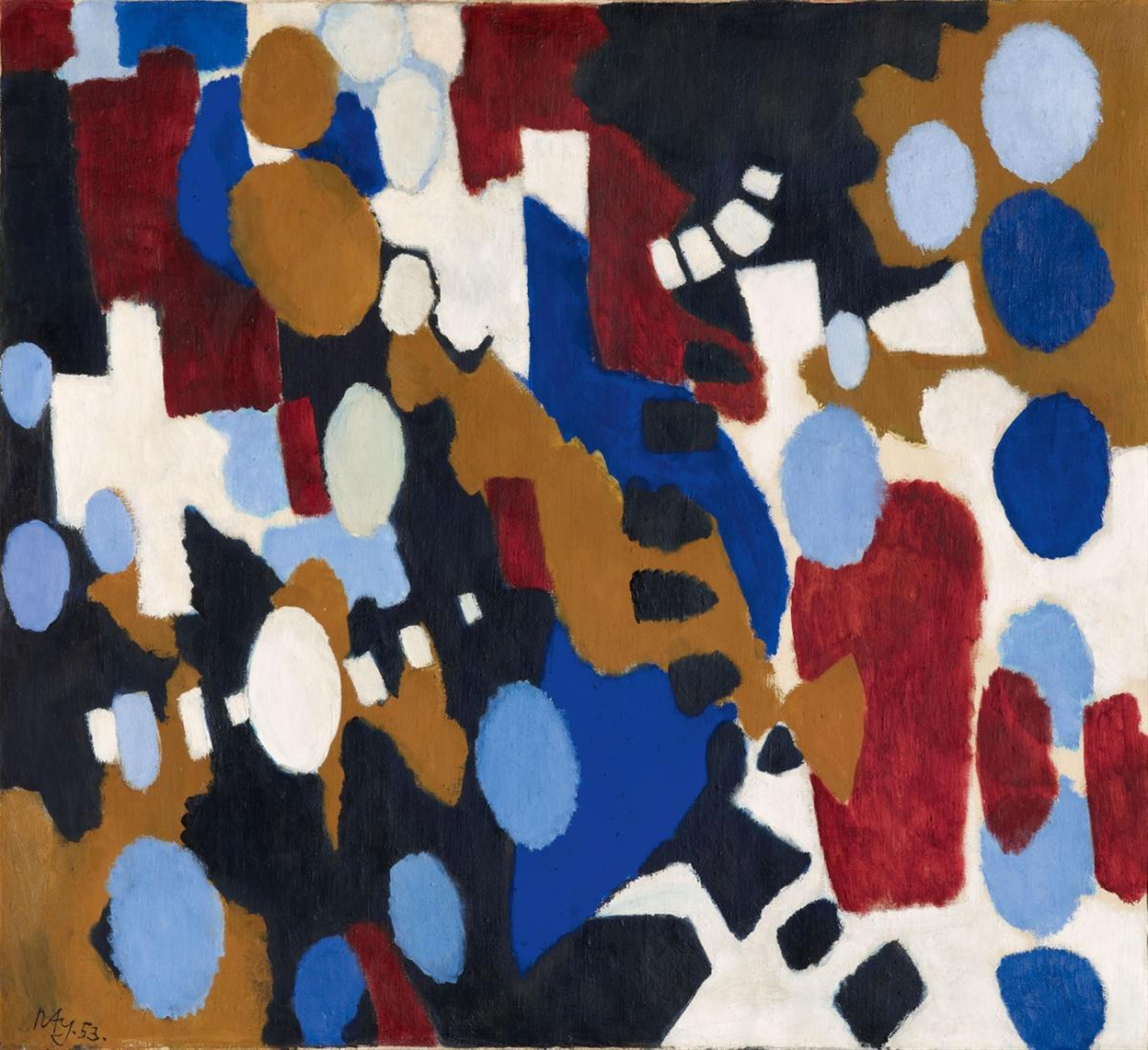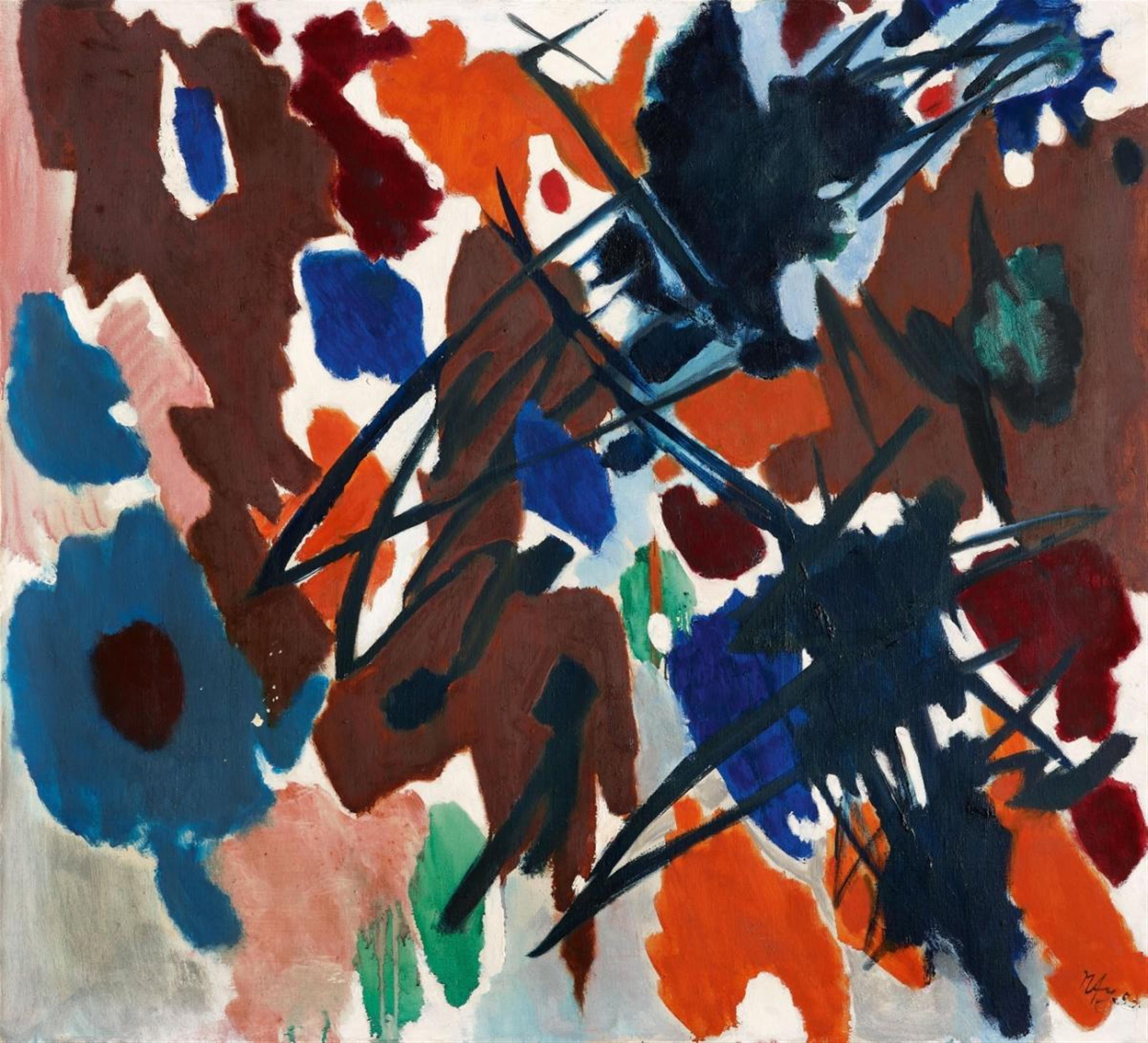Ernst Wilhelm Nay
In Blockformen
1953
Two-sided work: One of the compositions rotated by 180°. Each oil on canvas.. 100 x 110 cm. Framed. Each signed and dated 'Nay 53'. - On the verso, the lower margin with minor retouching. Edge-reinforced in order to be able to present both of the work's sides. The original stretcher is missing.
According to Scheibler, the artist had originially overpainted the verso and it was posthumously re-exposed after 1990. Nay used an old, inscribed stretcher frame for this painting.
Ernst Wilhelm Nay was stationed as a soldier in France from 1940-1945, first in the south, and from 1942 in the north at Le Mans. Although defamed as a 'degenerate' in Germany, he was still able to continue painting alongside his military service. With small drawings and watercolours he developed compositions, which he expanded into gouaches and a few, small-format oil paintings. Through his friendships with the lawyer and art collector Hans Lühdorf and the amateur sculptor Pierre de Térouanne he moved into a studio in Le Mans, as well as profiting greatly in many practical ways from their good personal connections. Hans Lühdorf's extensive notes, made over the war years spent together with the artist, provide a vivid contemporary document, in which the present work 'Königin auf dem Thron' (lot 513) is mentioned: 'Nay used the colour red, as a symbol of blood, prevalently for particular body parts in his figurative pictures ('Königin auf dem Thron') to visualize the mystical bonds. Nay spoke of the 'topography of his color' (quoted from: E.W. Nay 1902-1968. Bilder und Dokumente, exhib.cat. Munich et al. 1980, p.86). Many artistic French and German visitors were greatly interested in his work, one of the most famous being the writer Ernst Jünger, who was a guest in Le Mans together with the art historian Fritz Baumgart in 1943. In his war diary 'Strahlungen', Jünger described the meeting with Nay and his impressions of his artwork.
After his Lofoten pictures of 1937/38, whose flat, abstracted figural and landscape depictions were determined by a dynamic, crystalline-looking design language, Nay turns in this time in France to quieter, more detailed style. He concentrated on figural images, which blended with the surroundings into an ornamental structure. 'The majority of the works show thematically legendary scenes, in which abstracted figures appear to be bound to an intensely personal, tragic or euphoric event. ( . . .) The white strokes and rows of dots which suggest the spines of both figures in 'Königin auf dem Thron' (cat. no. 328), make the skeletal form of the body visible. In contrast to this Memento mori, the harmonically warm colour scheme with the dominant use of yellow and its combination with light red lifts the pictures to a bright, spirited tonal harmony. Nay softens the heat of these fire colours with a spectrum of brown and green tones. In order to flatten the otherwise perspectively emerging intervals in his compositions, Nay designed a motif of an alternately repeating chessboard pattern.' (Elisabeth Nay-Scheibler, in Ernst Wilhelm Nay. Werkverzeichnis der Ölgemälde, Cologne 1990, vol.1, p.198).
Nine years later, he painted the double-sided work 'In Blockformen' (lot 514), revealing his complete renunciation of all representational forms. This development towards pure abstraction paralleled Nay's move from rural Taunus to Cologne in 1951. Elisabeth Nay-Scheibler characterized these works from 1952/53, produced in a lively big city atmosphere, as 'Rhythmical pictures', moulded by the artist's affinity to new music. Nay frequently attended concerts by composers such as Arnold Schönberg, Béla Bartok and Paul Hindemith as well as the avant-gardists Pierre Boulez and Luigi Nono, with whom he exchanged ideas about musical and painterly parallels.
The abstract compositions of this period show, for the most part, light and dynamic rounds of loosely placed, open colour forms and line structures. These features are also found on the reverse of 'In Blockformen' - a composition which, according to information from Aurel Scheibler, the artist had overpainted and which was released posthumously in 1990. It is dominated by large coloured areas of brown and orange tones, which are animated by black zigzag lines and contrasting blue and blue-grey colour forms, producing a powerfully dynamic composition. The composition on the front however shows a somewhat quieter character with soft, rounded forms. The complete lack of lineal structure here hints already at the Scheibenbilder which Nay worked on from 1955. White, light blue and dark blue ellipses sway together with small, rounded square shapes in front of a harmonious colour combination of black, dark red, dark blue and ochre. The remaining white areas do not stand as individual forms, but as illuminated background areas, underscoring the impression of swaying lightness. Nay himself wrote about this phase of his work: '1952, following strict constrictions, came an intense dispersal of the pictorial form. However a formal objectivity is always a direct requirement for my art; increasingly rhythm came to discharge - rhythm of the surface. The theme of the surface area, which actually remained constant, was conceived in terms of ellipsoidal light processes. It took me years to create a complete and obvious clarity for the picture, and I have keenly observed the transformations from this viewpoint. ' (quoted from: Retrospektive E.W. Nay, exhib.cat. Cologne/Basel/Edinburgh 1992, p.34).
Catalogue Raisonné
Scheibler 694
Provenance
Dr. Wickert, Berlin; private collection, Berlin




